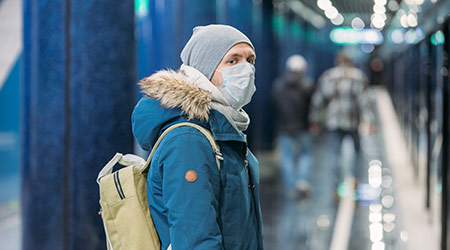
Contributed By CloroxPro
Each year it is often questioned by those in the medical and infection control community “what can the U.S. learn from Australia’s Flu Season?” and this year is no different.
Last year, Australia’s flu season came two months earlier than normal and peaked around June. Early on, most of the cases were caused by influenza A, but as the season wore on, the proportion of cases caused by influenza B increased. The 2019 U.S. flu season also came a little early, but was characterized by an initial spike of influenza B which then receded before influenza A hit.
Of course, this year, communities are living in an entirely different world than 12 months ago. In the U.S., there have been some warnings and concern that the country may get hit with a double threat of COVID-19 and influenza during this year’s flu season. However, if you look at the current data coming out of Australia, which is in the middle of winter and therefore its influenza season, it provides an interesting perspective and may contain learnings for the U.S.
In Australia, lock down began in late March, a little before influenza cases generally start to pick up. Many areas of the country eased restrictions toward the end of May and into June, but some went back into lock down in July in response to regional surges in cases. This is typically peak influenza season in Australia. For much of the lock down period, wearing a mask was only recommended for those caring for a COVID-19 patient, but recently, the health department has recommended wearing masks when community transmission is occurring and when physical distancing is difficult. Additionally, as in most countries around the world, schools and universities have been closed and public gatherings prohibited.
Like COVID-19, influenza is a respiratory illness and is spread in similar ways, mostly by droplet transmission. Consequently, with these precautions in place, it’s interesting to learn that influenza cases in Australia are markedly down compared to 2019, a particularly bad year. Numbers from Australia’s National Notifiable Diseases Surveillance System show that in the first seven months of 2020, Australia reported 21,000 cases of influenza compared with around 214,000 for the same period of time in 2019. Deaths for that same period are also down, from 486 in 2019 to 36 in 2020. These are huge reductions.
"I think if we could get this sort of effect every year, we'd be very happy," says Professor Ian Barr, deputy director of the World Health Organization Collaborating Centre for Reference and Research on Influenza, to the Australian Broadcasting Corporation.
This one bright spot in an otherwise difficult year has been welcomed amongst Australian medical professionals. The lower rate of community transmission of influenza is perhaps not surprising; the precautionary measures such as social distancing being taken for COVID-19 also help prevent the spread of influenza. Additionally, the shutting down of schools and aggressively closing borders are likely to be major contributors. A 30 percent increase in the number of influenza vaccinations administered is also thought to have helped Australia keep its influenza cases lower.
“The lessons seem clear: social distancing, the wearing of masks in public places, the closure of public spaces that are generally hotbeds for the transmission of influenza, border closures, and high vaccination rates can all help prevent the spread of COVID-19 AND influenza,” says Richard Lowe, associate research fellow, CloroxPro. “And these results aren’t just limited to Australia. Other countries in the southern hemisphere such as Argentina, Chile, and South Africa are also reporting large decreases in influenza cases as well, thanks in part to implementation of COVID-19 prevention measures."
In fact, the U.S. may have already seen the benefits of these measures earlier this year. Speaking to the U.S. edition of the The Guardian, Dr. Richard Kennedy of the Mayo Clinic’s vaccine research lab said that shutdown measures “shaved four to six weeks” off the U.S.’s 2019-2020 flu season earlier this year.
Unfortunately, implementation of such preventative measures varies widely across the country, and border closures have not been as aggressively implemented as in Australia. Meanwhile, flu vaccination rates are also low – according to the Centers for Disease Prevention and Control (CDC), flu vaccination rates hover at around 50 percent or less each year
With flu season approaching, it seems reasonable to assume that measures to prevent the spread of COVID-19 can also help to prevent the spread of influenza. Aggressively adhering to these measures gives the U.S. the chance of avoiding the “double whammy” of a winter of COVID-19 and influenza, something that may once again place an enormous burden on hospitals and communities nationwide.
Richard Lowe is an Associate Research Fellow within the CloroxPro Clinical and Scientific Affairs team. He serves as a technical expert for the company’s business across the healthcare continuum. In this role, he is responsible for leading a wide range of technical, clinical and educational initiatives that support the company’s portfolio of healthcare cleaning and disinfecting solutions. He also works closely with colleagues in sales and marketing, Global Stewardship and product research to bring those initiatives to life.
Lowe earned his Ph.D. in chemistry from the University of Manchester in the United Kingdom and his Master's Of Public Health degree from the University of California, Berkeley. He is currently a member of the Association for Professionals in Infection Control and Epidemiology (APIC), the Society for Healthcare Epidemiology of America (SHEA) and the U.K.’s Healthcare Infection Society.

 Celebrating BSCAI's 60th Anniversary eBook
Celebrating BSCAI's 60th Anniversary eBook The Down and Dirty on Cleaning in Virus Season
The Down and Dirty on Cleaning in Virus Season How Surfactant Use is Expanding in Commercial Cleaning
How Surfactant Use is Expanding in Commercial Cleaning